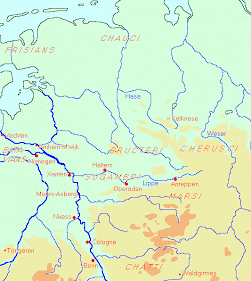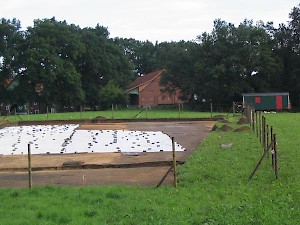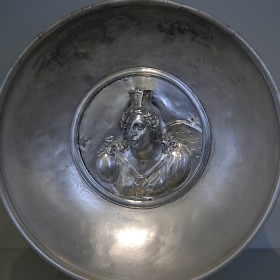Beyond Anreppen
Anreppen: site of a Roman military base on the banks of the river Lippe. There must have been another base in the neighborhood.

What were Roman ambitions in Germany? Not so long ago, history handbooks stated that the Romans wanted to conquer all the land up to the river Elbe. However, the written sources do not confirm this and the archaeological evidence suggests the contrary: that Roman ambitions were limited to the land west of the Weser; all known military settlements in Germania lie to the west of this river, which is halfway between the Rhine and Elbe.
The area between the Weser and the Elbe was visited only three times: by reconnaissance expeditions quite as spectacular as the Roman campaigns to Meroe and Arabia Felix, yet not intended to push back boundaries. That the Romans wanted to advance to the Elbe is nothing more than an unconfirmed hypothesis.
However, there is more to be said. The Weser is navigable up to a place called Hedemünden, where the rivers Werra and Fulda unite. At this place, archaeologists have found a Roman fort that was built in c.10 BCE – in other words, by Drusus. It must have been a supply base, where the population brought grain to be shipped to troops that were somewhere downstream. So, somewhere along the Weser, there must have been a base so large that it could not be fed from its own neighborhood. We do not know where it was.

A similar problem arises at the legionary base of Anreppen, the easternmost known Roman settlement on the Lippe, founded in 4 CE. This may have been the place where, according to Velleius Paterculus (an officer who fought in Rome’s German Wars), the Roman army stayed in the winter of 4/5 CE.note We can be sure that there was another Roman settlement beyond this point, because at the eastern gate of Anreppen, there are remains of a paved street. It must have led somewhere, but we have no idea where, nor of its purpose.
Here, we have a gap in our knowledge. It is plausible that the lost legionary base is identical to the site at the Weser that was supplied from Hegemünden. (Of course there may have been two camps, but Ockham’s Razor suggests that the better hypothesis is that there was only one.) The number of possible locations is limited, because between Anreppen and the Weser are the Egge Mountains. There are two roads: one leads to Paderborn and ends at Hamelin, the other (the medieval “Hellweg”) leads to Minden. Both towns are near the Weser.

Hamelin or Minden: somewhere in that area must have been a Roman military base, which could have been used during the exploratory expeditions beyond the Weser, in the direction of the Elbe, in 9 and 1 BCE and in 5 CE. It may also have been the place where Varus spent the summer of 9 CE before he led the Seventeenth, Eighteenth, and Nineteenth legions to their doom in the Teutoburg Forest. And it may have been from this base that Germanic warriors stole the famous silver treasure that has been excavated at Hildesheim.
Identifying that base would be a great discovery. If we find it in a somewhat defensive position, it would suggest that the Romans were satisfied with annexing the fertile land west of the Weser. If there is a bridge, then Rome may have had ambitions beyond the Weser, in the direction of the Elbe. Perhaps archaeologists will one day find such a base, but for the moment we do not know how far the Romans wanted to penetrate into Germany.